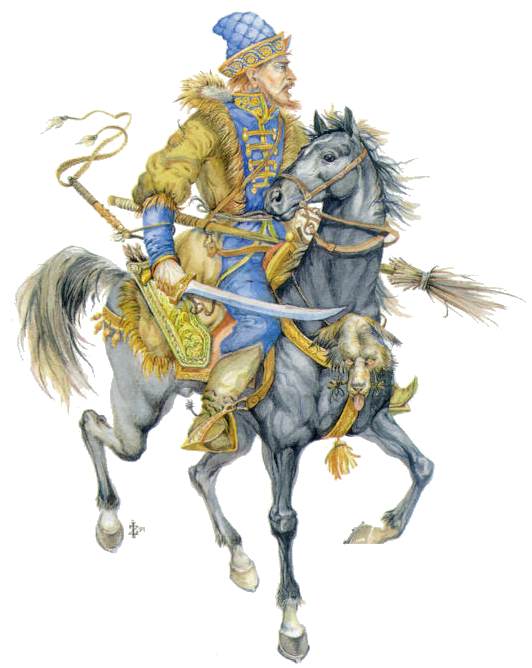by C N Hammersley
Part One - The Lithuanian Campaign
Miniature Wargames No 163 - December 1996

Grand Prince Ivan III, also known as Ivan the Great, ruled Muscovy from 1462 to 1505. In 1476, Contarini, a Venetian traveller, described Ivan as "tall, lean and handsome" in political and military matters Ivan avoided frontal combats. He preferred to achieve his aims through calculated and devious diplomacy. However, this series of articles should prove how successful he was when he did resort to force and violence, even if it was as a last resort.
For all the conquests of Ivan's forerunners, on his accession he found Muscovy flanked by enemies. To the north he was flanked by the huge commercial republic of Novgorod the Great, which dominated a vast stretch of land from the Gulf of Finland to the Urals. In the East, the Tartar Khanate of the Golden Horde and the splinter Khanate of Kazan, loomed threateningly. To the South lay the vast steppeland expanse, stretching as far as the Caspian and Black Seas, and crossed by bands of wandering Tartar bandits, but dominated by the powerful Krim Horde, based in the Crimea and now subject to the all powerful Ottoman Porte. Muscovy, to the West, faced Lithuania, whose domains ran from the Baltic to the Black seas, screened by a few, but equally hostile, mini states such as Tver, Yaroslavl and Rostov. This western border was extremely ragged and open to controversy, local lords or Bojars changed allegiance between Princes regularly, to suit themselves.
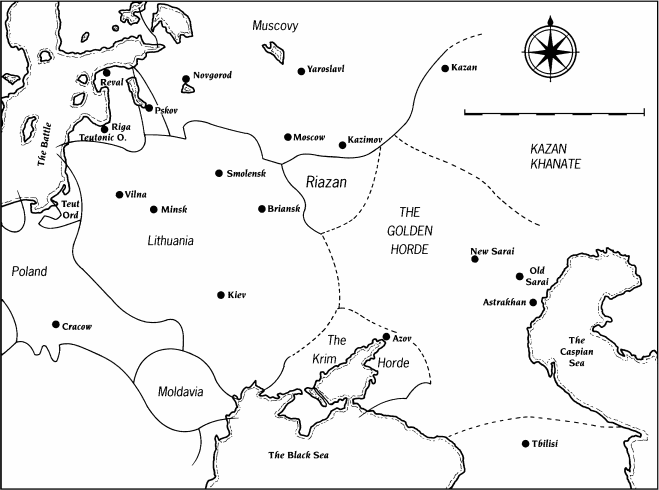
From the start of Ivan's reign, he began to consolidate his power and then expand his realm. He absorbed many of the lesser Russian states and in 1489 Novgorod also, thus bringing Muscovy into direct contact with Lithuania. Ivan now concentrated on his two main opponents - Lithuania and the Tartar's. This was a complex, interdependent problem, with Ivan manoeuvring uneasily between the west and south, endeavouring to prevent a union of the two fronts. His technique was to exploit his enemies divisions, which with the very much fragmented Tartar people was relatively easy, Lithuania posed more of a threat.
In 1492 Ivan founded the town of Ivangorod near the mouth of the Narva, thus opening a corridor to the Baltic and base for operations against Lithuania from the North. Here Ivan had fortifications built using the latest technology imported via the recently employed Italian architects and stone masons. Prior to this Russian forts and castles had been built in wood and in an unplanned way. Ivangorod took account of the use of can non, a new concept in Russian defence architecture, and was built in stone and in a regular oblong plan.
In 1493 Ivan assumed the title of Sovereign or Gosudar of all Russia, a reference to the Kievian state which was considered the "Golden Age" of Russia and now partially incorporated into Lithuania. An act which heightened tension with it's powerful with its powerful neighbour in 1494 it appeared an easing of the situation occurred when a Treaty was signed between the two. This Treaty was crowned by the marriage of Helena, Ivan's daughter, to Alexander Grand Duke of Lithuania.
If Ivan was hoping that this marriage would increase his influence in Vilna, and Alexander that it would bring peace, and even help against Tartar raids, one of the terms of the Treaty, both sides were to be disappointed. One of Ivan's first acts was to inform his ally, Mengli-Girey, the Krim Tartar leader, that this Treaty would change nothing with Crimean/Muscovite relations. On his part Alexander continued to westernise Lithuania, strengthening ties with Poland and founding Catholic Churches in his realm.
It was during this period that a number of Orthodox princes on the Oka and beyond the Dnieper transferred their allegiance from Alexander to Ivan. Alexander tried to prevent these defections by peaceful means but was unsuccessful.
These defections should be looked at:
It is true that Alexander did encourage Catholic Churches to be built in Lithuania and was himself a Catholic. But their is no evidence of religious persecution, certainly not by the standards of the day. His wife, Helena, was an orthodox Christian, as were many of his nobles. There is no evidence he tried forcibly to convert her or anyone else. He did not try and ban or prevent the Orthodox rite being practised in his lands. it appears that whatever religious fear existed was being exaggerated by Ivan, probably for his own political aims. It certainly was not Alexander's policy to have the Orthodox religion persecuted. Yet it was Ivan's reason for declaring war on Lithuania in 1499.
On 14 July 1500 on the Viedrosa River a Lithuanian force, led by the hetman Constantine Ostrogski, was defeated by the larger Muscovite army. Ostrogski had allowed himself and his men to be separated from Alexander's main force, who were near Borysovo and was himself captured along with his artillery and supplies. However, due to a revolt in Kazan, in Ivan's rear, the Muscovites were forced to withdraw before encountering Alexander and his depleted army. Alexander thus gained time to improve his frontier defences. Towns such as Polock, Witebsk and Smolensk were fortified. Also allies were sought, Walter von Plettenberg, leader of the Teutonic Knights in Livonia, and Saih-Ahmed ruler of the Golden Horde. Help was also sought by the Lithuanian and West Russian lords who stayed loyal to Alexander from Poland.
There were new defections to Ivan in 1500, the princes of Novgorod-Severski and Chernigov, both on the Desma River, and the prince of Starodub, all joined him. Also around this time Ivan inherited, from the Prince Ivan of Riazan, half of his principality and was appointed warden of the other half during the minority of the young heir.
In 1501 the Teutonic Order became allies of Lithuania against Muscovy and opened a northern front, diverting a large portion of the Muscovite army away from the Lithuanian border Also the Golden Horde attacked Muscovy splitting the Russian forces again. In the summer of 1501 Saih Ahmed, Khan of the Golden Horde, occupied Rylsk and advanced as far as Briansk, while in the north, Waiter von Plettenberg won a series of successes against Ivan and his allies. Alexander advanced against Muscovy towards the close of July, but this was short lived, turning his force again he headed west.
This move was against all expectations, his allies Saih-Ahmed and Plettenberg had expected their armies to unite and advance on Moscow. Ivan was desperately trying to keep the respective armies from joining one another. The reason for the withdrawal was the death of Jan Olbracht in June. Jan was Alexander's brother and more importantly ruler of Poland. Poland, at this time, was an elective monarchy and Alexander wanted the throne for himself. The reasons for his departure may have been to strengthen his power for the defence of Lithuania against Muscovy or it may have been for selfish motives and personal aggrandisement, but the immediate effect was to leave his borders open and allow Ivan to attack Alexander's weaker allies without fear of Lithuanian counter attack in Poland the gentry who elected the king initially wished Ladislas of Bohemia and Hungary to rule and entered into negotiations with him.
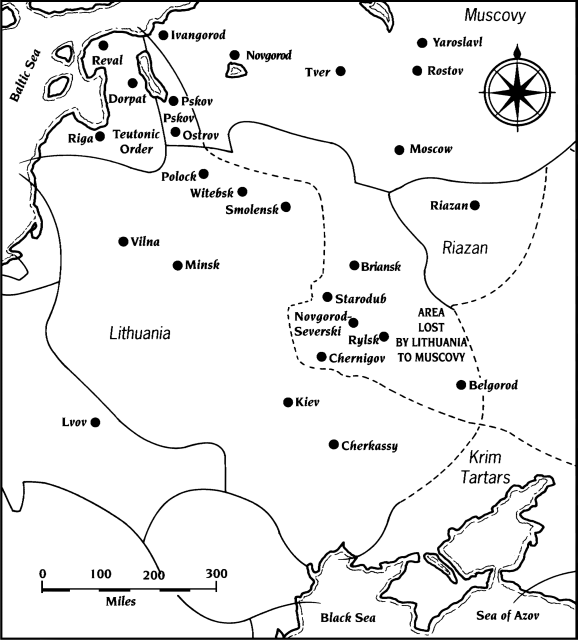
|
The negotiations did not go well for Ladislas and with Alexander's arrival and his promises of non interference along with bribes, the Polish Lords were soon won over to his candidature. In October Alexander was obliged to issue a new act of union between Poland and Lithuania in Mieinik, on the border of Lithuania. On 25 October a new second act was announced, it stipulated for the first time the joint election of the Polish King and the Grand Duke of Lithuania in Piortrkow. The Jagellon's thus lost their hereditary rights in Lithuania. The second act made the King merely an executor of the Senates decisions and limited his right to confer office. This was clearly a reaction against the strong rule of Jan Olbracht Alexander was eventually voted in as King and on 12 December crowned in Cracow, but not be, fore the bishops had objected that the Grand Duchess Helena was orthodox and therefore could only be "the wife of the King and not Queen". The Coronation Diet, assembly of Lords for the Coronation, then voted taxes and a general levy. An envoy was then sent to the Ottoman Court to confirm the truce concluded by Olbracht was still valid if the Poles fought against the Krim Tartars, who were subjects of the Ottoman Sultan, in defence of Lithuania. Alexander then gave viceregal powers to the Senate, raising Cardinal Frederick as Regent, before returning to Lithuania in 1502.
In early July Alexander arrived at Nowogrodek to find the situation dramatically changed from that he had left.
Saih-Ahmed and his Golden Horde had been routed by Mengli-Girey and his Krim Tartars in the spring of that year.
Ivan's armies had advanced into Lithuania occupying the lands of Chernigov, and were now advancing further west.
Smolensk, which was being gallantly defended by Stanislas Kiszka, was under Muscovite siege, led by Grand Duke Basil of Moscow. The only good news was that Plettenberg's campaigns in the north were diverting Muscovite troops away from Lithuania.
Alexander could do little except wait and try and defend his border cities the best he could with his thinly spread army. Winter arrived and by mid-October the siege of Smolenskwas raised leaving the town in Alexander's hands. The huge lands of Chernigov and Seversk along with a broad tract of borderland to the east of Smolensk, Witebsk and Polock remained with the occupying Russians.
On 28 March 1503 Alexander signed a treaty with Ivan, who had been persuaded by his daughter to parley, in which he surrendered all lands then in Ivan's possession and agreed to a six year truce.
Ivan's one concession was the return of six significant conquered villages to Lithuania.
The Muscovite/Pskovti Military Organisation
Both the armies of Muscovy and Pskov would be dressed and equipped the same, in a "Russian" manner. The main difference being in numbers, Muscovy was vast and contained a larger population and therefore larger reservoir for troops, Pskov was much smaller and proportionally had more towns and so would have had more infantry, to defend these towns.
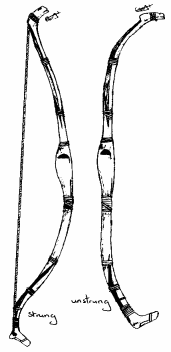 Composite Bow, made largely of wood with horn spliced into the belly side and sinew reinforcements on the back. |
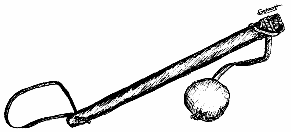 A Kisten, which was an Iron knob on a stout leather strap attached to a short handle. |
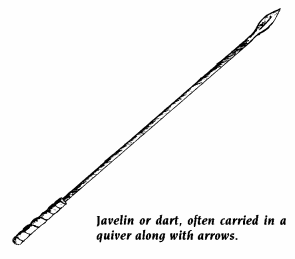
|
Russian armies were basically cavalry armies, with very few infantry and some artillery. As a fighting body the Russians were badly trained and undisciplined, lacking in staying power. If the first furious charge turned out to be a failure, they would turn tail. For a long time they used the same tactics as the Tartars, consisting of sudden charges followed by abrupt withdrawals.
Muscovite cavalry were supplied from three main sources: Ivan's entourage, or the Dvorani; the nobility of Bojars; and thirdly the "Sons of Bojars", or lesser nobility these held small areas of land in return for military service. This third area was instigated by Ivan to act as a balance against the more powerful Bojars and was mustered in town contingents, and were accompanied by armed retainers. All were armed and equipped in a similar manner, the richer horsemen having better furs and silk's. But all were basically armed with bow, light lance, sword and mace or Kisten, a simple "ball and chain" weapon. Armour could be either padded, plate, mail or scale or a combination of any two or more.
The Russian cavalryman would have ridden horses similar to the Tartars, small scraggy mounts, which were seldom shod and capable of living on next to nothing. The Russian horseman led an extremely frugal existence carrying with him his rations usually consisting of crushed millet, salt pork and a little salt, he would be expected to obtain other sustenance off the land himself.
It should also be remembered that Tartars would have served in Ivan's armies, Muscovy having its own Horde since 1446, that of Kasimov. The Kasimov Khanate dates back to when two Kazan princes, Kasim and his brother, fled to Basil II's court and were granted lands around the town of Gorodets (later becoming Kasimov) on the Oka river.
From then it became a reliable source of border guards, troops, military advisers, and pro-Muscovite Khans.
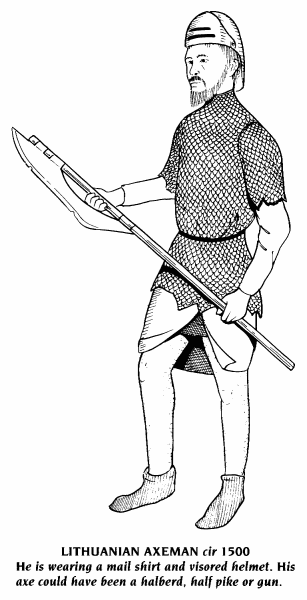
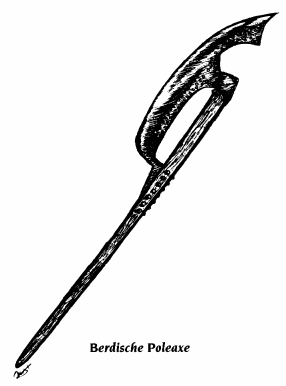
As has been said a small number of infantry were employed, these being used to defend the towns, forts and important crossing points i.e. bridges, fords, crossroads etc. In the main they consisted of mercenaries and levies. The mercenaries were better equipped and armed, some having the new handgun (the first indisputable record of Russian troops using handguns dates only to 1480, when the "Vologda-Perm Chronicle" mentions their use against the Tartars at Ugra River). The levies, who were "called to arms" only when required, had very little weapons training, being only serf's, farmer's or townspeople, they used whatever weapons came to hand, spears, knives, clubs and axes, but principally the bow. Another reason for the lack of Russian infantry was the difficulty it had in keeping large bodies of townsmen and peasants under arms for long periods without paralysing the business of state and the losing of harvests.
Artillery was introduced during the late 15th century. In 1474, 1488 and 1499 Ivan obtained from Italy a number of engineers some of whom were gun founders, who encouraged the use of bronze cannon and iron cannon balls. But artillery was of secondary importance, being only really used in sieges or for defending towns. Russian towns and forts, however, had a serious lack or cannon, even in the newly constructed fortress at Ivangorod.
The Lithuanian Military Organisation
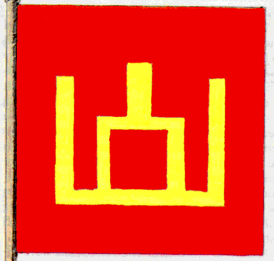
The Lithuanian Flag "The Columns of Gediminas"
Lithuania was a large country but with a small population, large parts of the country were covered with primeval forests, marshes and vast areas of steppe. Large and important towns dotted the area, but apart from Vilna its capital, the others were inhabited in the main by the West Russians. The most important of these towns were Minsk, Smolensk and Kiev. The population of Lithuania was, in fact, made up of many different peoples, only a small number of these were Lithuanian, the majority being Russian, but Poles, Tartars, Samogitians, Livs, Letts, Circassians and Jews made up the rest.
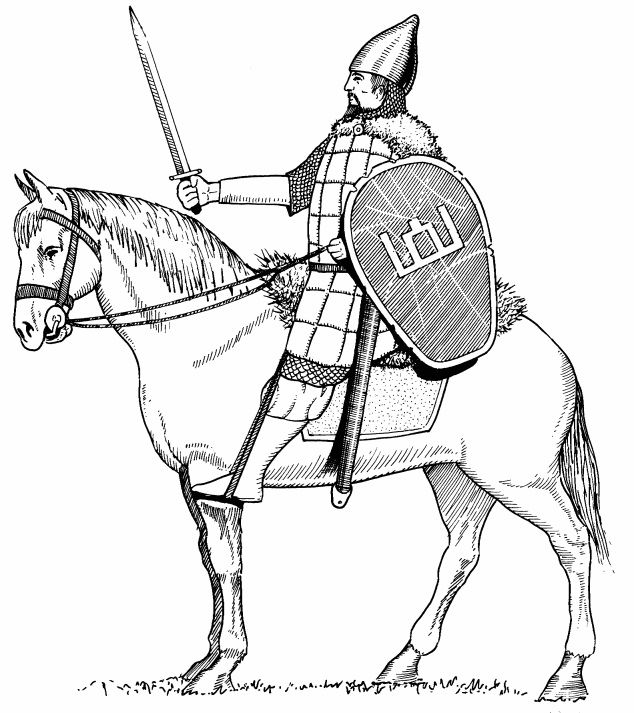
A LITHUANIAN "BOJAR" circa 1500
This nobleman is protected by mail and padded armour, a simple helmet and large shield. He is armed with a sword, but could also have a mace, lance or bow.
In 1389 Lithuania united with Poland, but as an independent country ruled by a lesser member of the ruling dynasty, the Jagellon family. After this date it became somewhat of a political backwater, a poor borderland country, with the East.
All men were obliged to perform military service, the majority fighting as cavalry, although there were some infantry, the Lithuanian Army like Poland was cavalry based. These troops were formed into units, under a banner of between 200 and 250 men, often led by their own Bojar or lord, who may have lead several banners, or a number of lesser Bojars may unite to form one lesser banner. The Grand Duke himself had his own retainers and nobles who owed him service directly and this band was organised on a semi-regular basis so as to be available at short notice. This force was billeted on the local population and at this time numbered around 3,000 horsemen. The other banners, if not supplied by their own lord, were expected to provide their own rations for a period of around a month.
The cavalry consisted of Bojars, who would fight as mailed horsemen armed with spear, sword and shield. Their armour would be considered "old fashioned" by their Polish brothers, and generally of a poorer manufacture. To add to this primitive appearance lynx or wolf skin was often worn as a cloak and the helmet could have a fur trim.
In addition light cavalry archers were supplied by Tartars who lived within the Lithuanian borders. The Tartars were descendants of the Mongols and allied Asiatics who had swept across Eastern Europe in the 13th century, when these armies left many stayed. Grand Duke Witold at the end of the 14th century encouraged those living the nomadic Tartar life in Lithuania to marry Lithuanians and settle around the Vilna area. By our period there were around 200,000 Lithuanian Tartars, speaking Polish or Byelorussian and worshipping Allah. As with other Lithuanians they performed military service for their land. They were armed and dressed as other Tartars (see next months article), however, many wealthy Tartars wore mail shirts in the Polish or Lithuanian style. In contrast to other Tartar forces they were not organised on the decimal system, but in Polish "comrade" or "banners" of 60 to 200 men.
Traditional horsetail standards or tugs were used as well as flags. The Tartar flags were usually green and some carried inscriptions from the Koran, others had scorpions, griffins or birds which represented the personal badges of the groups chief.
Lithuanian infantry were in the main supplied by the towns and used for garrison duty or in defence of the town walls. When they were used in the field they formed a support arm for the cavalry, defending the baggage train, or camp.
They were armed in a similar manner to medieval Western types, as crossbow and pavise-men, protected by plate or mail armour, axes, sabres, spears and clubs being other popular weapons.
Artillery had been introduced into Lithuania in 1382, and though never numerous was used both in the field and for the defence of towns. Additionally Town Cossacks were employed in the defence of frontier towns or outposts. They were recruited individually on a full or part time basis in exchange for money or goods. Some were given plots of land to farm, which they would retain for life, but would be liable for continued military service. Records of the Lithuanians using Cossacks date back to the late 14th century.
They were light irregular horse, similarly armed as Tartars, but could be of any ethnic stock i.e. Russian, Lithuanian, Tartar etc.
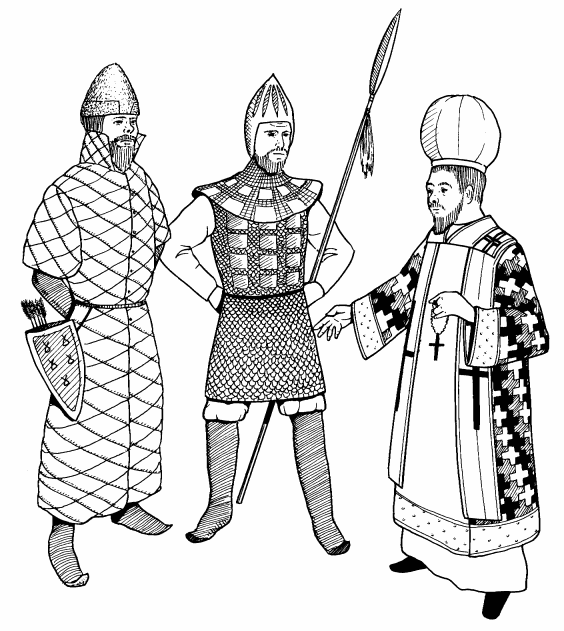
A Russian Bishop blessing Russian Bojars. The bishop is dressed in a dalmatica, a wide garment worn without a belt, over this the pailium, no longer the large Roman cloak but now a long woollen band embroidered with crosses. (Costume taken from a Russian icon cir 1500). The Bojars are wearing a variety of armour, padded, chain, plate, etc.
